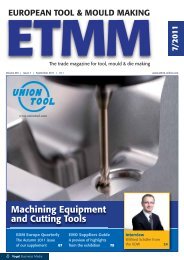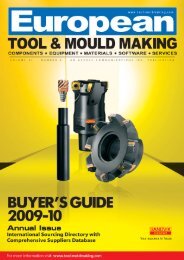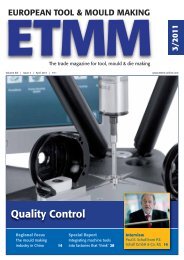Hot Runners and Mould Components - ETMM-Online
Hot Runners and Mould Components - ETMM-Online
Hot Runners and Mould Components - ETMM-Online
Create successful ePaper yourself
Turn your PDF publications into a flip-book with our unique Google optimized e-Paper software.
some parts must be produced.<br />
Anyone who ever<br />
tried to make adjustments<br />
to a hanging mould in a<br />
small room will know that<br />
this is far from ergonomic.”<br />
So, right from the outset,<br />
Koller GmbH has not compromised.<br />
The fifth machine<br />
the company acquired was a<br />
spotting press, <strong>and</strong> it was<br />
recently using several models<br />
from various manufacturers.<br />
But when the mould<br />
maker needed to try out<br />
larger moulds than before,<br />
it searched the market to<br />
find a new solution.<br />
Finding the Right<br />
Press<br />
The height of Koller’s industrial<br />
shed <strong>and</strong> cranes presented<br />
a construction constraint.<br />
“Our new press had<br />
to be very compact <strong>and</strong><br />
installed on the ground to<br />
allow for ergonomic h<strong>and</strong>ling<br />
of the moulds,” Max Koller<br />
explains. “We wanted to develop<br />
a very efficient <strong>and</strong> user-friendly<br />
tryout process.” Thus, the company<br />
screened several manufacturers<br />
in looking for an optimal<br />
solution.<br />
Koller’s search ended at Millutensil.<br />
The Blue Line MIL 303<br />
had exactly the characteristics<br />
required. Its four-cylinder control<br />
keeps the machine compact <strong>and</strong><br />
minimizes overall height. Further,<br />
the pressing force is evenly distributed<br />
over the entire surface of<br />
the table.<br />
A key reason for deciding in<br />
favour of purchasing the MIL<br />
303 was the h<strong>and</strong>ling of moulds<br />
on the machine. “We especially<br />
liked the fact that, after the tryout,<br />
the punch <strong>and</strong> counterpunch<br />
are automatically brought to a<br />
position where they can be easily<br />
reworked or machined by the<br />
toolmaker,” reports Koller. The<br />
www.etmm-online.com | May 2011 | European Tool & <strong>Mould</strong> Making<br />
“Zero milling” is an illusion, especially with large moulds. A tryout<br />
press ensures accuracy to the last hundredths.<br />
punch rotates up to 180° <strong>and</strong> is<br />
then taken down from the press;<br />
the counterpunch travels laterally<br />
from the press <strong>and</strong> can be rotated<br />
up to 70° on each side.<br />
Says Koller: “This makes both<br />
of them easy to access <strong>and</strong> ensures<br />
top visibility for the operator on<br />
all crucial areas, in order to rapidly<br />
identify the ones where reworking<br />
is required <strong>and</strong> implement the<br />
needed measures.”<br />
Powerful, Yet Sensitive<br />
The Millutensil press can clamp<br />
powerfully, but it is also very sensitive.<br />
Four lasers situated alongside<br />
the press accurately control the<br />
parallelism. “The machine is set to<br />
a tolerance range of 2/10, which is<br />
unique in the field of mould making,”<br />
notes Max Koller. “Reaching<br />
that value alerts the control unit of<br />
a clear sign of failure.”<br />
The machine has an intelligent<br />
» Millutensil S.r.l.<br />
Milan, Italy<br />
www.millutensil.com<br />
Case Studies<br />
control system capable of<br />
detecting errors <strong>and</strong> safely<br />
driving the tool sections<br />
back. “This ensures that the<br />
mould is not damaged, even<br />
when a hammer is accidentally<br />
left there,” says Koller.<br />
Hydraulic connections<br />
enable the user to move the<br />
extractors of the mould’s<br />
threading taps <strong>and</strong> slides on<br />
the press so that a complete<br />
cycle can be performed in<br />
one go. Placement <strong>and</strong> holddown<br />
force can be accurately<br />
adjusted. Optionally, the<br />
press can be configured in<br />
such a way as to produce a<br />
first prototype with injected<br />
wax. Koller GmbH does not<br />
use this feature, however,<br />
as its injection presses are<br />
efficient enough.<br />
‘An Essential Aid’<br />
The company does not use<br />
the Millutensil tryout press<br />
for new moulds only. “The<br />
machine is an essential aid for<br />
repairs <strong>and</strong> modification of used<br />
moulds,” Max Koller explains,<br />
“as this task normally involves<br />
many different manual reworking<br />
phases.”<br />
Offering ergonomic workstations<br />
<strong>and</strong> easy h<strong>and</strong>ling of mould<br />
components, the press enables<br />
the company’s employees to react<br />
quickly, even when the necessary<br />
changes or repairs are complex.<br />
These are often carried out<br />
overnight, so that the mould can<br />
be used again the next day with<br />
minimal production downtime.<br />
This flexibility <strong>and</strong> the capability<br />
to react quickly to OEM manufacturers’<br />
needs constitute important<br />
selling points for a mould<br />
manufacturer active in Germany,<br />
as Koller can attest.<br />
35












